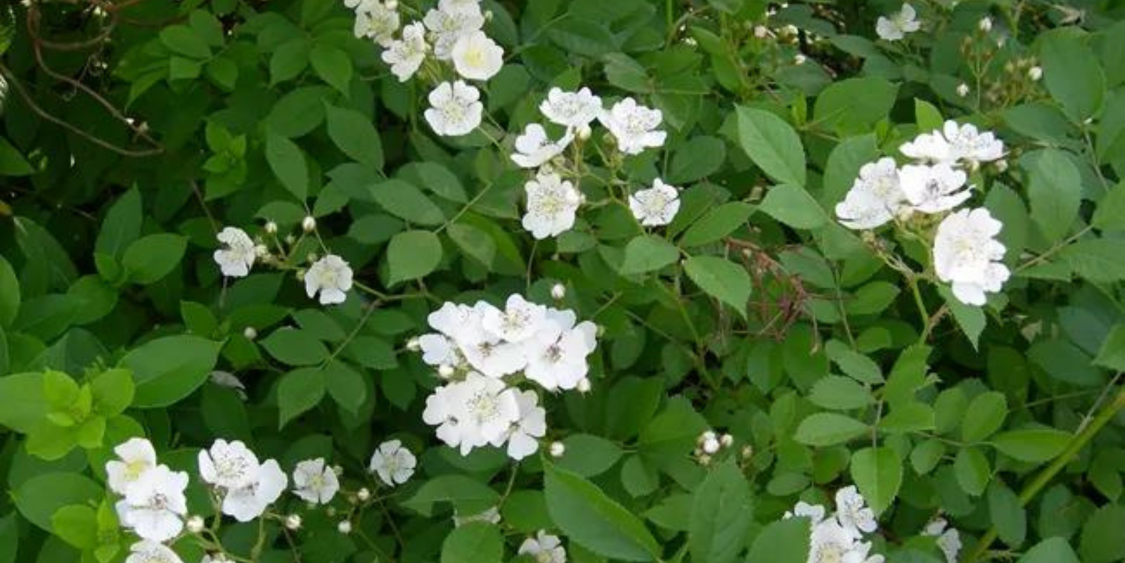By John McFerrin
It seemed like a good idea at the time. Hybrid roses needed a sturdy root stock to graft desirable varieties onto. Asia had a sturdy, common rose variety that fit the bill. So, in the 1860s, we imported the multiflora rose.
The multiflora rose can grow anywhere. It prefers sunshine but, in a pinch, it can get by in deep forest. It thrives in poor soil and spreads prolifically. It can grow into dense thickets that neither animals nor people can penetrate.
With these attributes it is a natural candidate for, what else, a living fence. From the 1930s until at least the 1950s, the United States Department of Agriculture promoted the multiflora rose as a “living fence.” The idea was that a farmer could plant multiflora rose along edges of farm fields. It would grow into an impenetrable thicket that would confine livestock with no postholes to dig, no wire to string, etc.
A 1950s United States Department of Agriculture Bulletin describes it this way, “LIVING fences of multiflora rose are used on more American farms every year. Only recently have farmers come to realize the many advantages of this plant. Chief among these is the fact that it will make a living fence that will keep both your livestock and your soil within its boundaries.”
The Bulletin describes a living fence as a “thing of lasting beauty.” It recommends planting 1,000 plants to produce 1,000 feet of living fence. This will be the result: “Unlike other fences that must be repaired or replaced, multiflora rose fences last a lifetime and will continue to serve your children.” According to the Department, the multiflora rose “provides an excellent living fence for pastures where horses, cattle, sheep, and goats are grazed.” The Bulletin points out that it will also prevent trespassing.
The Bulletin goes on to give useful tips on selecting plants to plant, soil conditions, when to plant, etc. The living fence was not the only application for multiflora rose. It was also widely planted to control erosion.
That was then; this is now.
At West Virginia University there is an ongoing research project that seeks to determine whether drones can detect multiflora rose. Fortunately, the goal of the research project is to test and improve drone technology, not detect the presence of multiflora rose. We already know where multiflora rose is: it’s everywhere.
It is in every state east of the Mississippi, including every county in West Virginia. According to a map published by the National Invasive Species Information Center of the United States Department of Agriculture, there are only eight states where one could go to escape it. Fleeing to Canada is not much better; it is found throughout eastern Canada, too.
From its beginnings as a living fence or an erosion prevention tool, the multiflora rose has gone on to choke whole farm fields, crowd out native species, and bedevil landowners everywhere. It has even been shown to benefit ticks, the ones that spread Lyme disease.
Once established it is devilishly hard to eradicate. The recommended method is catching it when it is small and ripping it out by the roots. Failing that, it is recommended that it be cut it off at the ground and an herbicide applied to the stump. It is possible to eradicate by mowing although it takes repeated mowing to discourage it enough that it will give up and die. Goats will eat it, although deer will not.
A single plant can produce up to a million seeds per year which are spread by birds who eat the seeds. A seed can remain viable for up to twenty years while it waits for the right conditions to sprout.
Those who first imported multiflora rose to North America are long gone. There is no record of who first came up with the living fence idea. Since promotion of the multiflora rose as a living fence began almost a hundred years ago, the originator of that idea is gone as well. Yet we still have it, a curse upon our fields and woodlands, a good idea gone bad.
Giving the devil his due: the multiflora rose is a favorite habitat of mockingbirds who eat its fruits and nest within the protection of its brambles. So, there’s that.

